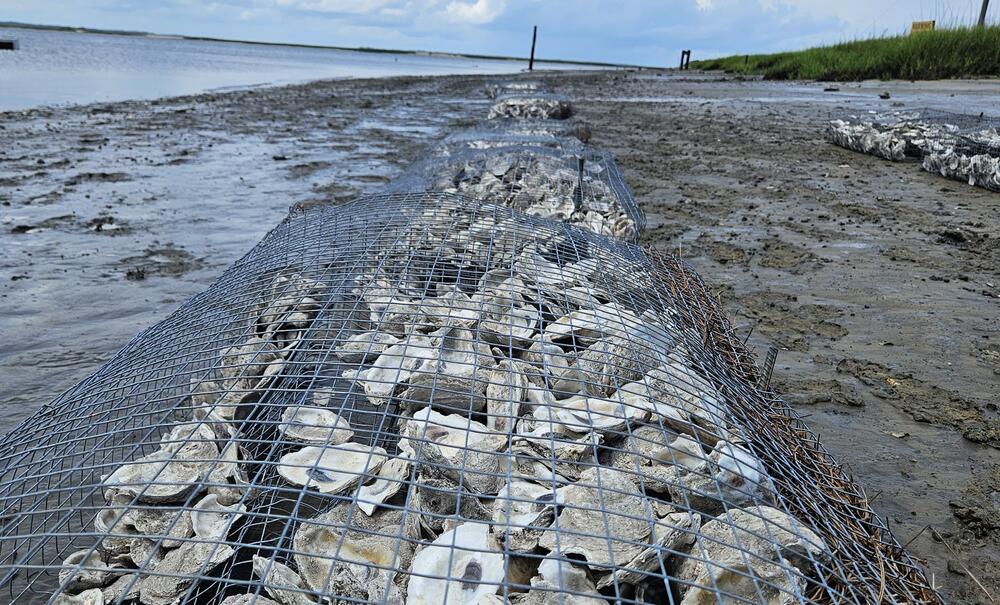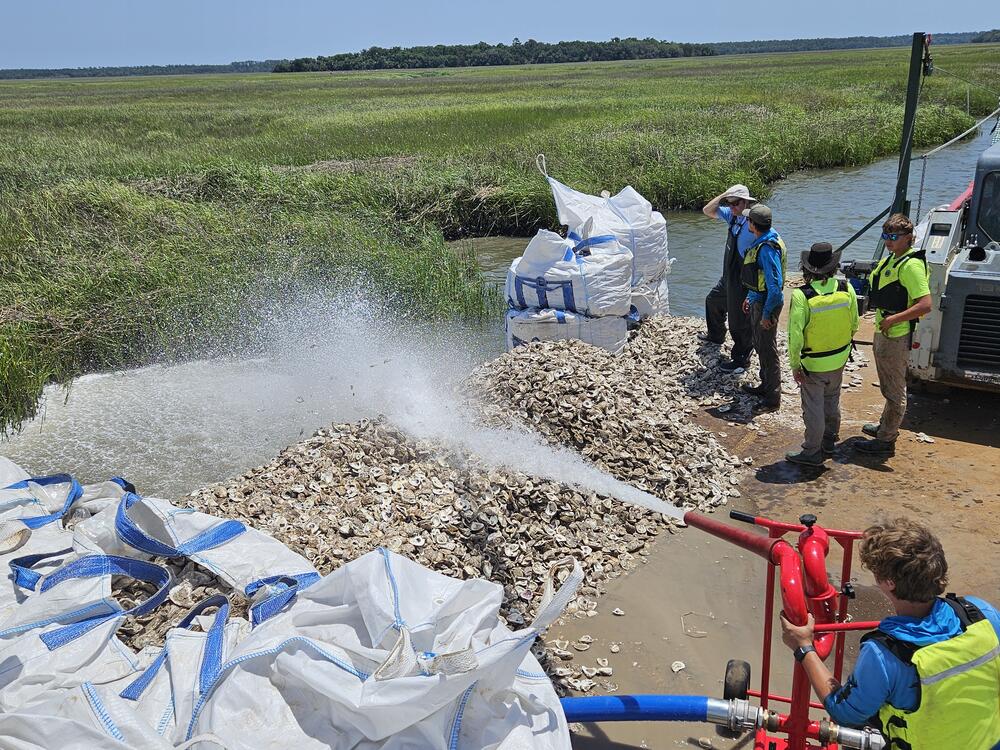
Caption
Wire mesh cages containing oyster shells and pine straw are designed to help rebuild oyster reefs along Teakettle Creek in McIntosh County.
Credit: Cameron Brinton / Georgia Department of Natural Resources
|Updated: June 6, 2025 8:54 AM
LISTEN: Wildlife officials are trying out a first-of-its-kind oyster restoration strategy in Coastal Georgia using wire mesh cages at a popular shellfish harvesting area. GPB's Benjamin Payne reports.

Wire mesh cages containing oyster shells and pine straw are designed to help rebuild oyster reefs along Teakettle Creek in McIntosh County.
The Georgia Department of Natural Resources is deploying a restoration method never before used in the state to rebuild oyster reefs at a popular shellfish harvesting area near Sapelo Island.
At Teakettle Creek in McIntosh County, Department of Natural Resources crews are testing wire mesh cages packed with oyster shells and lined with pine straw to prevent mud accumulation and provide clean substrate for oyster larvae to attach.
"What it'll do is it'll provide, within a couple of years, some good growth of oyster beds there," said DNR spokesman Tyler Jones, explaining that the structures would also create fish habitat beneficial for recreational anglers while helping to stabilize shorelines as a buffer against storms.
The experimental cages — roughly the size of large suitcases — represent one component of a two-part restoration effort, begun in May, as the DNR is simultaneously deploying approximately 360 cubic yards of loose oyster shell using barges equipped with heavy machinery and pressurized water systems that blow the material onto the banks.

DNR crews use pressurized water to install loose shells along the banks of Teakettle Creek.
The agency has placed about 32 of the wire cages in the water, with plans to add more throughout the year for a total coverage area of about 450 square feet, according to Jones, who noted that staff and volunteers from church groups, civic organizations, and companies have helped construct the labor-intensive modules.
Teakettle Creek sits on the inland side of Sapelo Island and serves as the designated public shellfish harvesting area for McIntosh County, making restoration efforts particularly important for recreational use.
"It's been pretty well picked over," Jones said of the area, emphasizing the need to replenish shell substrate for continued oyster bed growth.
The initiative addresses a fundamental challenge in oyster restoration: Larvae floating in the water column require hard surfaces such as existing oyster shells to attach and develop, but shell removal from estuaries eliminates these critical settling sites.
Jones explained that the wire cages offer advantages over previous methods involving bagged oyster shells, which tend to sink into the region's soft pluff mud, which has "almost the consistency of chocolate pudding."
The metal cages should provide sufficient support to prevent sinking while offering a more durable, plastic-free alternative that creates better surfaces for reef development, he said.
Weather conditions and extreme tidal ranges present ongoing challenges for the restoration work, with the Georgia coast experiencing some of the highest tidal amplitudes on the East Coast at 8 to 9 feet.
"We're very dependent on the tides of when we can and can't do this work," Jones said, adding that the remote location requires transporting a 40-foot pontoon boat from Brunswick to McIntosh County for each work session.
The DNR sources oyster shells from multiple partners, including restaurants in Atlanta that donate shells collected by the University of Georgia.
Commercial shell purchases supplement the donated material, with all shells requiring a curing period of six months to a year in the sun to eliminate bacteria and prevent introduction of non-native species into estuaries.
Beyond supporting recreational harvesting, the restored oyster beds will provide significant ecological benefits through natural water filtration, as individual oysters are capable of filtering approximately 50 gallons of water daily.
The project is permitted to continue through next year, when the DNR plans to launch a third method of oyster reef restoration using modules made of cement and jute fiber installed across roughly 1,000 square feet.